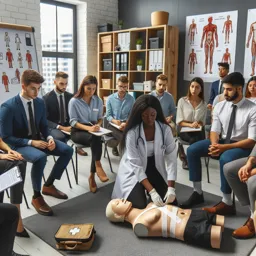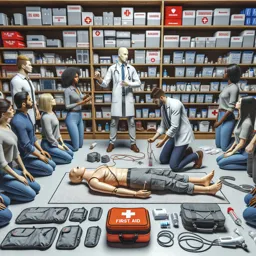Course content
Introduction to first aid
2Importance of first aid
3Essential first aid equipment
4How to prepare a first aid kit
5First aid for cuts and wounds
6First aid for burns
7First aid for fractures
8First aid for animal bites and stings
9First aid for choking
10First aid for electric shocks
11First aid for drowning
12First aid for heatstroke and dehydration
13First aid for hypothermia and frostbite
14First aid for heart attacks
15First aid for cerebrovascular accidents (CVA)
16First aid for asthma attacks
17First aid for epileptic seizures
18First aid for severe allergies and anaphylaxis
19First aid for food poisoning
20First aid for drug or alcohol poisoning
21First aid for diabetic emergencies
22psychological first aid
23First aid for pediatric emergencies
24First aid for geriatric emergencies
25First aid for obstetric emergencies
26First aid for mental health emergencies
27First aid in natural disaster situations
28First aid in traffic accident situations
29First aid in situations of violence
30First aid training and certification
31First aid laws and regulations
32Ethics and consent in first aid
33How to stay calm in emergencies
34How to ask for help in emergencies
35How to do CPR (Cardiopulmonary Resuscitation)
36How to Use an Automated External Defibrillator (AED)
37How to treat shock and post-traumatic stress
38How to prevent common accidents and injuries
39How to recognize signs of medical emergencies
40How to take care of yourself after giving first aid
Course Description
The "Complete First Aid Guide" is an extensive and invaluable resource that falls under the Health category, specifically within the First Aid subcategory. This 40-page guide is meticulously designed to equip individuals with the essential knowledge and skills needed to respond effectively in a myriad of emergency situations. Whether you are a healthcare professional, a caregiver, or simply a responsible citizen, this course provides critical insights into the fundamentals of first aid.
The journey begins with an "Introduction to First Aid" where the basics are laid out, making it accessible even to beginners. Following that, the "Importance of First Aid" is emphasized, highlighting why being prepared can make a life-saving difference. Equipped with this foundational understanding, the guide delves into "Essential First Aid Equipment" and "How to Prepare a First Aid Kit," ensuring you're always ready for any emergencies.
Various types of injuries and conditions are comprehensively covered. You will learn about "First Aid for Cuts and Wounds," "Burns," "Fractures," as well as "Animal Bites and Stings." The guide addresses critical emergencies like "Choking," "Electric Shocks," "Drowning," "Heatstroke and Dehydration," and "Hypothermia and Frostbite." It also includes life-threatening conditions such as "Heart Attacks" and "Cerebrovascular Accidents (CVA)."
Special scenarios receive focused attention, with sections on "Asthma Attacks," "Epileptic Seizures," "Severe Allergies and Anaphylaxis," "Food Poisoning," and "Drug or Alcohol Poisoning." The guide doesn’t overlook chronic conditions, providing guidance on handling "Diabetic Emergencies" and offering "Psychological First Aid."
Demographic-specific emergencies are well-detailed as the guide includes chapters on "Pediatric Emergencies," "Geriatric Emergencies," and "Obstetric Emergencies." Mental health crises are addressed with "First Aid for Mental Health Emergencies," ensuring a well-rounded understanding of both physical and psychological aspects of first aid.
In addition to personal emergencies, the guide prepares you for broader scenarios like "First Aid in Natural Disaster Situations," "Traffic Accident Situations," and "Situations of Violence." Essential procedural knowledge is provided with "First Aid Training and Certification," understanding "First Aid Laws and Regulations," and the critical aspect of "Ethics and Consent in First Aid."
The ability to stay composed is crucial. Sections on "How to Stay Calm in Emergencies" and "How to Ask for Help in Emergencies" are designed to bolster your confidence. Learn life-saving procedures such as "How to do CPR (Cardiopulmonary Resuscitation)" and "How to Use an Automated External Defibrillator (AED)." The guide goes further to teach "How to Treat Shock and Post-Traumatic Stress," as well as strategies for "Preventing Common Accidents and Injuries."
Recognizing signs of danger quickly is vital, covered in "How to Recognize Signs of Medical Emergencies," while personal aftercare is not overlooked with "How to Take Care of Yourself After Giving First Aid."
In essence, the "Complete First Aid Guide" is a holistic educational tool that empowers you with the knowledge to act promptly and effectively in any emergency, making it an indispensable resource for ensuring safety and well-being in diverse situations.
This free course includes:
Audiobook with 1h50m
40 content pages
Digital certificate of course completion (Free)
Exercises to train your knowledge






















